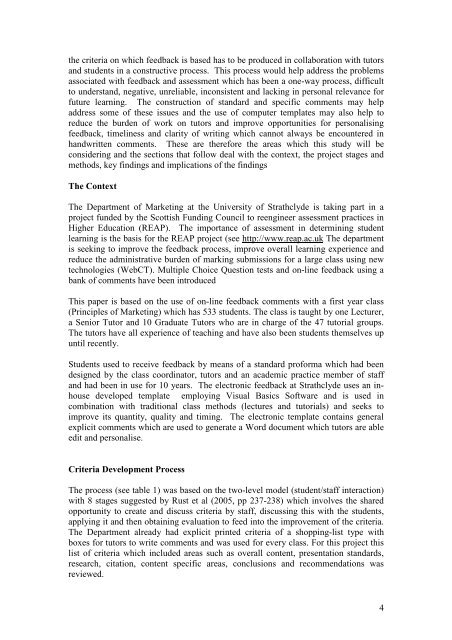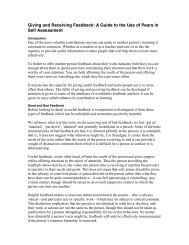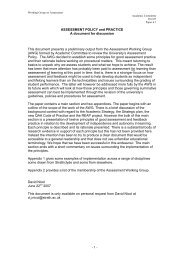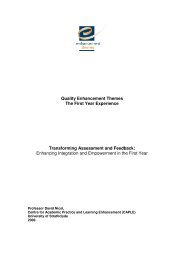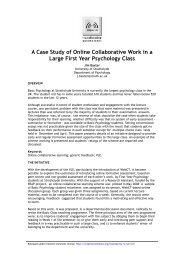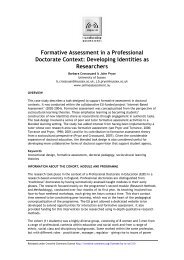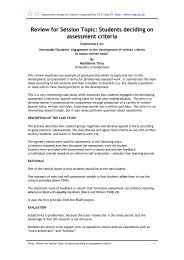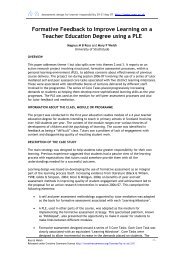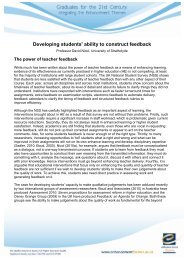Enhancing Student Learning using On-Line Submission and ... - Reap
Enhancing Student Learning using On-Line Submission and ... - Reap
Enhancing Student Learning using On-Line Submission and ... - Reap
You also want an ePaper? Increase the reach of your titles
YUMPU automatically turns print PDFs into web optimized ePapers that Google loves.
the criteria on which feedback is based has to be produced in collaboration with tutors<strong>and</strong> students in a constructive process. This process would help address the problemsassociated with feedback <strong>and</strong> assessment which has been a one-way process, difficultto underst<strong>and</strong>, negative, unreliable, inconsistent <strong>and</strong> lacking in personal relevance forfuture learning. The construction of st<strong>and</strong>ard <strong>and</strong> specific comments may helpaddress some of these issues <strong>and</strong> the use of computer templates may also help toreduce the burden of work on tutors <strong>and</strong> improve opportunities for personalisingfeedback, timeliness <strong>and</strong> clarity of writing which cannot always be encountered inh<strong>and</strong>written comments. These are therefore the areas which this study will beconsidering <strong>and</strong> the sections that follow deal with the context, the project stages <strong>and</strong>methods, key findings <strong>and</strong> implications of the findingsThe ContextThe Department of Marketing at the University of Strathclyde is taking part in aproject funded by the Scottish Funding Council to reengineer assessment practices inHigher Education (REAP). The importance of assessment in determining studentlearning is the basis for the REAP project (see http://www.reap.ac.uk The departmentis seeking to improve the feedback process, improve overall learning experience <strong>and</strong>reduce the administrative burden of marking submissions for a large class <strong>using</strong> newtechnologies (WebCT). Multiple Choice Question tests <strong>and</strong> on-line feedback <strong>using</strong> abank of comments have been introducedThis paper is based on the use of on-line feedback comments with a first year class(Principles of Marketing) which has 533 students. The class is taught by one Lecturer,a Senior Tutor <strong>and</strong> 10 Graduate Tutors who are in charge of the 47 tutorial groups.The tutors have all experience of teaching <strong>and</strong> have also been students themselves upuntil recently.<strong>Student</strong>s used to receive feedback by means of a st<strong>and</strong>ard proforma which had beendesigned by the class coordinator, tutors <strong>and</strong> an academic practice member of staff<strong>and</strong> had been in use for 10 years. The electronic feedback at Strathclyde uses an inhousedeveloped template employing Visual Basics Software <strong>and</strong> is used incombination with traditional class methods (lectures <strong>and</strong> tutorials) <strong>and</strong> seeks toimprove its quantity, quality <strong>and</strong> timing. The electronic template contains generalexplicit comments which are used to generate a Word document which tutors are ableedit <strong>and</strong> personalise.Criteria Development ProcessThe process (see table 1) was based on the two-level model (student/staff interaction)with 8 stages suggested by Rust et al (2005, pp 237-238) which involves the sharedopportunity to create <strong>and</strong> discuss criteria by staff, discussing this with the students,applying it <strong>and</strong> then obtaining evaluation to feed into the improvement of the criteria.The Department already had explicit printed criteria of a shopping-list type withboxes for tutors to write comments <strong>and</strong> was used for every class. For this project thislist of criteria which included areas such as overall content, presentation st<strong>and</strong>ards,research, citation, content specific areas, conclusions <strong>and</strong> recommendations wasreviewed.4


